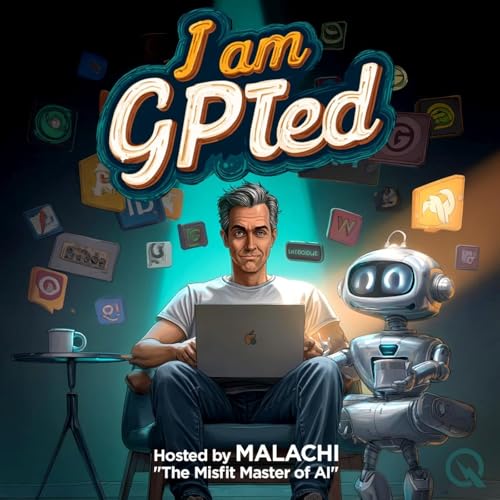
Mastering AI Prompts: Unlock Powerful Results with Strategic Role Playing
No se pudo agregar al carrito
Solo puedes tener X títulos en el carrito para realizar el pago.
Add to Cart failed.
Por favor prueba de nuevo más tarde
Error al Agregar a Lista de Deseos.
Por favor prueba de nuevo más tarde
Error al eliminar de la lista de deseos.
Por favor prueba de nuevo más tarde
Error al añadir a tu biblioteca
Por favor intenta de nuevo
Error al seguir el podcast
Intenta nuevamente
Error al dejar de seguir el podcast
Intenta nuevamente
-
Narrado por:
-
De:
Welcome back misfits, rebels, and future AI overlords—this is “I am GPTed,” and I’m Mal, the Misfit Master of AI. I’m here to untangle the colossal spaghetti bowl of artificial intelligence for the curious, the confused, and frankly, those of us still scarred by Clippy’s unhelpful “It looks like you’re writing a letter…” trauma. Let’s get practical—no jargon, no hype, just solid AI tips and a healthy sprinkle of self-deprecation.
Today, let’s talk about **role prompting**. If you want better results from ChatGPT, Claude, Gemini, or Grok, treat them like actors desperate for work. Give them a character and a backstory, and suddenly they shine.
Let’s see a bad prompt first:
“Summarize this document.”
Expected? Meh. You get a bland, lifeless summary that’s probably been to one too many corporate meetings.
Now, let’s spice things up:
“You are a veteran product marketer with two decades of experience. Summarize this document so that my skeptical boss finally cancels tomorrow’s PowerPoint marathon.”
Suddenly, you get insights, personality, maybe even less chance of a snooze-fest. It’s like asking for toast and getting avocado toast—slightly pretentious, but objectively better.
Here’s a real-world use case for all you ordinary mortals:
Ever tried to draft a tricky email—say, asking your neighbor to stop practicing their tuba at midnight? Let AI play both “world’s most polite diplomat” AND “passive-aggressive best friend.” Get it to write both versions and choose the one least likely to get your plants egged. Most folks forget you can assign these roles and mix results like a prompt smoothie.
Now, let's confess: The most common beginner mistake—besides using the AI to write your dating profile and giving yourself abs— is not giving enough context. Guilty as charged! I used to type “make a shopping list.” I'd get eggs, milk, sadness, maybe a rogue zucchini. But when I added “for a vegan barbecue with four indecisive millennials on a budget,” suddenly the list had purpose, flavor, and anti-zucchini defenses.
Want to practice? Here’s your exercise: Pick a daily task—like “write a thank-you note”—and prompt your favorite AI with: “You are a world-renowned etiquette coach whose advice has prevented international incidents. Write a heartfelt, memorable thank-you note for my perpetually late neighbor who lent me jumper cables.” Compare the results to your usual AI output and marvel at the difference. Rinse, repeat, and soon you’ll be the AI-whisperer your group texts fear.
Now, the secret sauce for evaluating AI’s answers: Don’t trust—verify. Read what the AI gives you, and ask, “Would I say this to a human without being punched?” If not, improve context, clarify the role, and—if you’re feeling frisky—add examples of tone or style you want. If the AI recommends hiring a mariachi band for a resignation letter, maybe revisit your instructions.
Alright, that's it for today’s wisdom. Subscribe to “I am GPTed”—because even your smart fridge needs our advice. Thanks for listening, for tolerating my dry wit, and for refusing to settle for mediocre AI results.
This has been a Quiet Please production. If you want to learn more or dig deeper, mosey on over to quietplease.ai—no tuba solos, guaranteed.
Stay weird, stay curious, and remember: the only dumb AI question is the one you didn’t prompt with enough sass. See you next time!
For more check out https://www.quietperiodplease.com/
and for some great deals go to https://amzn.to/4nidg0P
This content was created in partnership and with the help of Artificial Intelligence AI
Todavía no hay opiniones



